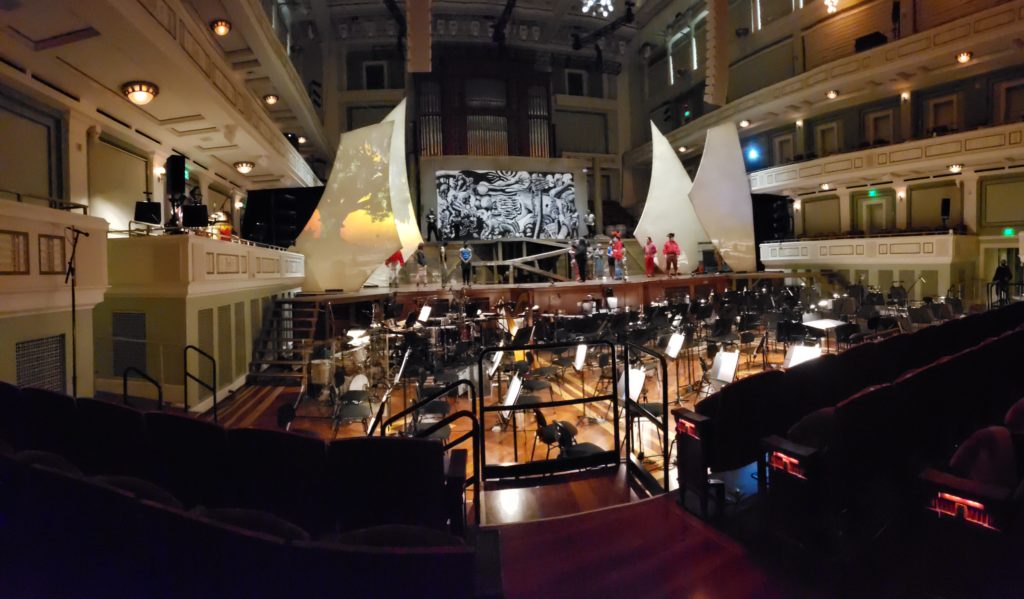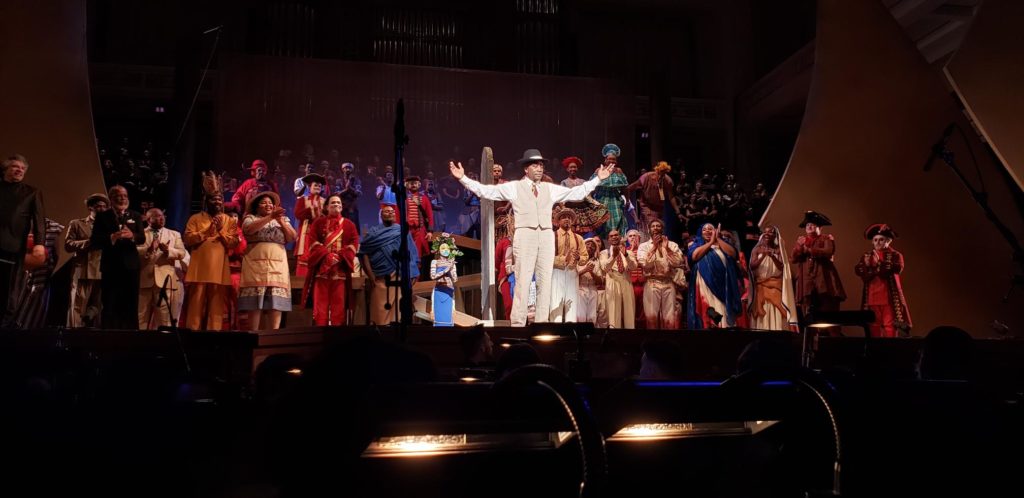On April 13–16, 2023, the Nashville Symphony performed a monumental work by Hannibal Lokumbe, The Jonah People: A Legacy of Struggle and Triumph, which was influenced by family history passed down from his great-great-grandmother.
The collaboration between Lokumbe and the Nashville Symphony began in 2019, when he visited for a performance of his piece Crucifixion Resurrection: Nine Souls A-Traveling. After attending an orchestra rehearsal of Carmina Burana and having a discussion with Nashville Symphony President and CEO Alan Valentine, the stage was set for the development of The Jonah People. Anyone who has ever been to the Schermerhorn Symphony Center knows the hall doesn’t have a traditional orchestra pit, so figuring where to put a full orchestra, African drums and other indigenous instruments, thirty actors and dancers, over one hundred chorus members (from the Nashville Symphony chorus, the Lloyd Mallory Singers, the W. Crim Singers, Lane College, and Tennessee State University)—as well as the massive sets and scrims—was quite an undertaking that required full engagement by a large portion of the staff. As with the Symphony’s performances of Carmina Burana, rows of audience seats had to be removed to fit the orchestra, and the chorus was seated behind a transparent screen behind the stage.

The reconfiguration of the Schermerhorn Symphony Center auditorium necessary to fit all of the elements of Hannibal Lokumbe’s The Jonah People Photo Credit: Laura Ross
Throughout the 2022–23 season, various workshops, concerts, and activities were scheduled in middle and high schools, community colleges, universities (Vanderbilt and Lipscomb Universities) and historically black colleges and universities (Fisk University, Tennessee State University), churches, community organizations, and the National Museum of African American Music. The orchestra also performed Young Person’s Concerts with Hannibal, exploring differences between Tchaikovsky’s Nutcracker Suite and Duke Ellington’s alternate version. There were quartet concerts featuring African American composers’ works that were linked thematically to portions of The Jonah People libretto—links that Lokumbe also shared with the orchestra prior to the first rehearsal of his work.
The project also generated other partnerships, including a pop-up installation allowing time to reflect, converse, and collect prayers from the community on cotton fabric that was later dyed to reveal these collective prayers. In many of these programs, Lokumbe related the story of his great-great-grandmother, Asase, who was kidnapped from Africa and sold into slavery in Charleston, South Carolina. Asase’s descendants would pass on the story that inspired a portion of the opera—how she crawled toward her new enslaver on her belly while being whipped, begging in a language he didn’t understand to purchase her children so they wouldn’t be separated.
At the beginning of our first rehearsal Lokumbe told the orchestra how music had not only saved his life but also helped him realize he wanted to dedicate his life to music. He related a story about a piece he was learning in band class that he wanted to play for his mother, but on his way home from school with his instrument, some bullies beat him badly; it was that desire to play for his mother and to keep playing music that kept him going during the healing process. In the program notes, Lokumbe states: “[Music] has had the ability to save my life. It saved my ancestors in the cotton field as well and gave them the strength to withstand the unrelenting sun. They withstood that by singing when it got too hot to even talk.”
The opera—which is very accessible—is constructed in “veils” rather than acts and is preceded by an overture by the orchestra and chorus. Lokumbe chose “veil” because “it has to do with our spiritual development. Sometimes in life, and in our understanding, we can move one step forward and then digress fifteen steps behind. When the Creator lifts the veil from our consciousness, we never go back to where we were before the veil of understanding was lifted from our minds.”

Hannibal Lokumbe bows at the conclusion of a performance of The Jonah People Photo Credit: Laura Ross
The story of The Jonah People begins in an African village before the arrival of slave traders and missionaries. Harvest is cut short by the appearance of a slave trader, a missionary, and an African chief. The production likens the past four hundred years of African American history, comparing it to the story of Jonah and the whale: surviving the horrors of slavery and injustice and seeing the promise of the future in the past and present. Veils I and II revisit the passage of the slave ship, the slave auction, and the discovery that music can help the enslaved workers endure their labors in the fields. Veils III and IV relate attempts to escape slavery and their outcomes: the Haitian revolt, a performance at Minton’s Playhouse jazz club in the 1950s with Lokumbe performing with the onstage band, and a scene in the Old Plateau Cemetery in Mobile, Alabama, which was founded by freed survivors of the last slave ship documented to reach the US from Africa.
Sometimes life and art are synchronous. This project—one that spent several seasons in the planning stages—occurred just after the mass shooting at Covenant School, when Nashville was awash in calls for gun control. Just days later the super-majority Republican legislature chose to reprimand and expel Justin Jones and Justin Pearson—two state house representatives from Tennessee’s two largest cities, Nashville and Memphis (who were reappointed by their respective cities’ metro councils days later).
As a city, Nashville is steeped in cultural and social contributions by Black people. During the Civil War it was the home of the Union Army’s US Colored Troops. It is the musical home of the Fisk Jubilee Singers, the TSU Aristocrat of Bands, and the National Museum of African American Music. And Nashville was home to civil rights leaders such as Diane Nash, founder of the Student Nonviolent Coordinating Committee (SNCC) that helped coordinate integrating lunch counters; John Lewis, who participated in sit-ins and devised the code of conduct for the lunch counter activities while attending American Baptist Theological College; Freedom Riders Rip Patton and Kwame Lillard; and Z. Alexander Looby, an attorney and teacher at Fisk University who was a leader in the desegregation of Nashville schools.
The musicians of the Nashville Symphony were proud to partner in such an important project and hope the message and the work will survive and thrive.





